How to Check Whether a Value Exists in Python List in a Fast Way
-
inMethod to Check if the Value Exists in the Python List - Convert List to Set and Then Do the Membership Check in Python
- Performance Comparison Between List and Set Membership Check
- Conclusion of Performance Comparison

We will introduce different methods to check whether a value exists in Python list and compare their performance.
The methods include,
- Membership check method -
inMethod to check whether the value exists - Convert list to
setand then use membership check methodin
in Method to Check if the Value Exists in the Python List
in is the proper way to do the membership check in Python list, set, dictionary or other iterable Python objects.
>>> testList = [1, 2, 3, 4]
>>> 2 in testList
True
>>> 6 in testList
False
Convert List to Set and Then Do the Membership Check in Python
The membership check in list could be inefficient if the list size increases, especially if duplicate elements exist in the list.
Python set is a better data type in this scenario to do the membership check because it only contains unique values.
Performance Comparison Between List and Set Membership Check
We will compare the performance differences in four situations,
- The original list has unique values, and the checked value exists in the list
- The original list has unique values, and the checked value doesn’t exist in the list
- The original list has duplicate values, and the checked value exists in the list
- The original list has only duplicate values, and the checked value doesn’t exist in the list
the Original List Has Only Unique Values, and the Checked Value Exists in the List
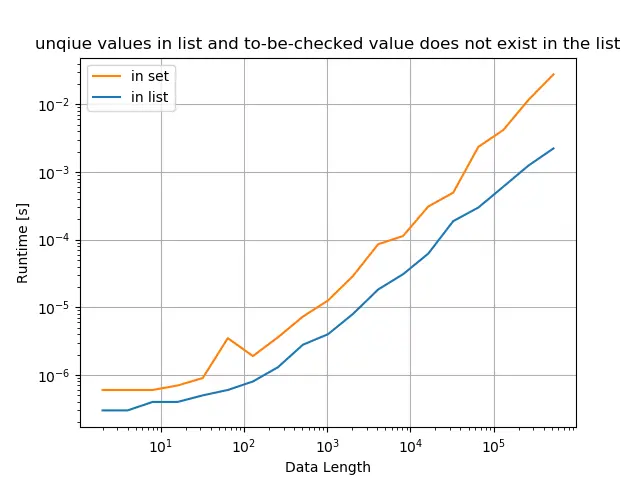
from itertools import chain
import perfplot
import numpy as np
def setupTest(n):
a = np.arange(n)
np.random.shuffle(a)
randomlist = a[: n // 2].tolist()
randomvalue = randomlist[len(randomlist) // 2]
return [randomlist, randomvalue]
def inListMethod(L):
x, y = L
return y in x
def inSetMethod(L):
x, y = L
x = set(x)
return y in x
perfplot.show(
setup=setupTest,
kernels=[inListMethod, inSetMethod],
labels=["in list", "in set"],
n_range=[2 ** k for k in range(1, 20)],
xlabel="Data Length",
title="unique values in list and to-be-checked value exists in the list",
logx=True,
logy=True,
)
the Original List Has Only Unique Values, and the Checked Value Doesn’t Exist in the List
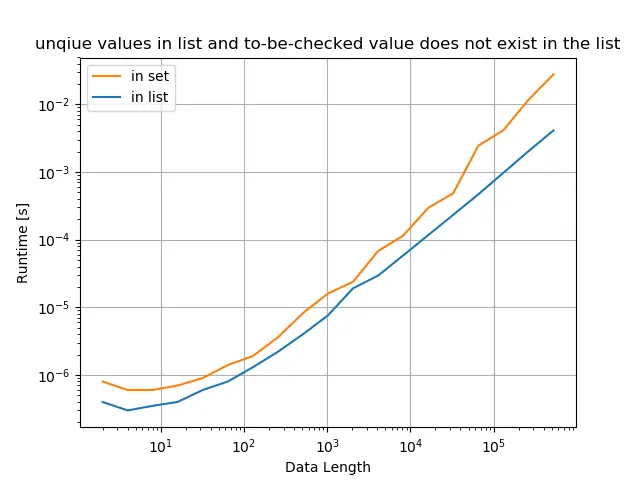
from itertools import chain
import perfplot
import numpy as np
def setupTest(n):
a = np.arange(n)
np.random.shuffle(a)
randomlist = a[: n // 2].tolist()
randomvalue = n + 1
return [randomlist, randomvalue]
def inListMethod(L):
x, y = L
return y in x
def inSetMethod(L):
x, y = L
x = set(x)
return y in x
perfplot.show(
setup=setupTest,
kernels=[inListMethod, inSetMethod],
labels=["in list", "in set"],
n_range=[2 ** k for k in range(1, 20)],
xlabel="Data Length",
title="unique values in list and to-be-checked value does not exist in the list",
logx=True,
logy=True,
)
the Original List Has Duplicate Values, and the Checked Value Exists in the List
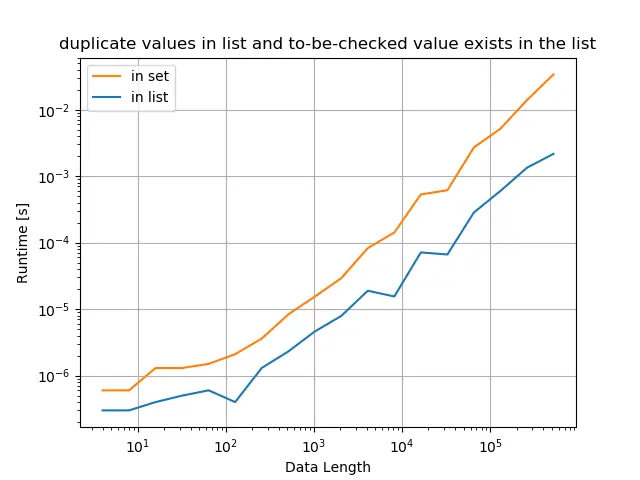
from itertools import chain
import perfplot
import numpy as np
def setupTest(n):
a = np.arange(n)
np.random.shuffle(a)
randomlist = np.random.choice(n, n // 2).tolist()
randomvalue = randomlist[len(randomlist) // 2]
return [randomlist, randomvalue]
def inListMethod(L):
x, y = L
return y in x
def inSetMethod(L):
x, y = L
x = set(x)
return y in x
perfplot.show(
setup=setupTest,
kernels=[inListMethod, inSetMethod],
labels=["in list", "in set"],
n_range=[2 ** k for k in range(2, 20)],
xlabel="Data Length",
title="duplicate values in list and to-be-checked value exists in the list",
logx=True,
logy=True,
)
the Original List Has Only Duplicate Values, and the Checked Value Doesn’t Exist in the List
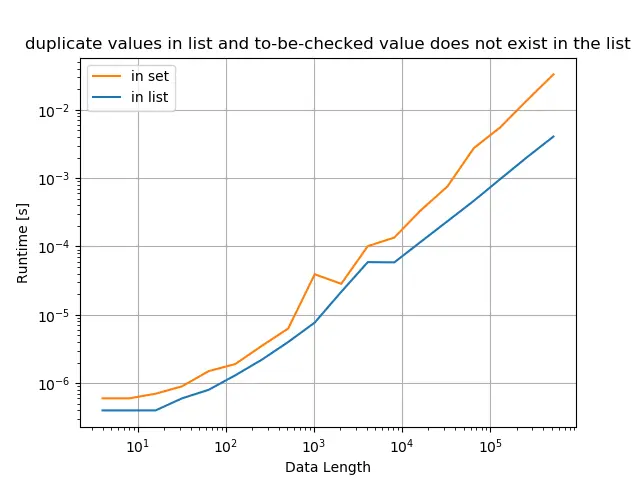
from itertools import chain
import perfplot
import numpy as np
def setupTest(n):
a = np.arange(n)
np.random.shuffle(a)
randomlist = np.random.choice(n, n // 2).tolist()
randomvalue = n + 1
return [randomlist, randomvalue]
def inListMethod(L):
x, y = L
return y in x
def inSetMethod(L):
x, y = L
x = set(x)
return y in x
perfplot.show(
setup=setupTest,
kernels=[inListMethod, inSetMethod],
labels=["in list", "in set"],
n_range=[2 ** k for k in range(2, 20)],
xlabel="Data Length",
title="duplicate values in list and to-be-checked value does not exist in the list",
logx=True,
logy=True,
)
Conclusion of Performance Comparison
Although membership check in Python set is faster than that in Python list, the conversion from a list or set consumes time. Hence if the given data is Python list, it doesn’t have any performance benefits if you first convert the list to set and then do the membership check in set.
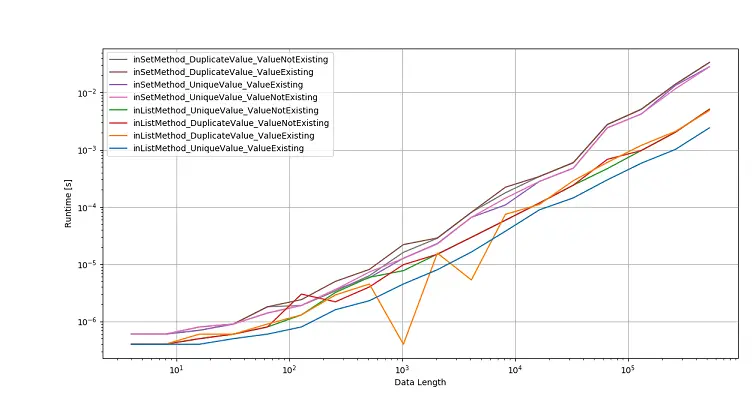
from itertools import chain
import perfplot
import numpy as np
def setupTest(n):
a = np.arange(n)
np.random.shuffle(a)
unique_randomlist = a[: n // 2].tolist()
duplicate_randomlist = np.random.choice(n, n // 2).tolist()
existing_randomvalue = unique_randomlist[len(unique_randomlist) // 2]
nonexisting_randomvalue = n + 1
return [
unique_randomlist,
duplicate_randomlist,
existing_randomvalue,
nonexisting_randomvalue,
]
def inListMethod_UniqueValue_ValueExisting(L):
u, d, ex, ne = L
return ex in u
def inListMethod_DuplicateValue_ValueExisting(L):
u, d, ex, ne = L
return ex in d
def inListMethod_UniqueValue_ValueNotExisting(L):
u, d, ex, ne = L
return ne in u
def inListMethod_DuplicateValue_ValueNotExisting(L):
u, d, ex, ne = L
return ne in d
def inSetMethod_UniqueValue_ValueExisting(L):
u, d, ex, ne = L
u = set(u)
return ex in u
def inSetMethod_DuplicateValue_ValueExisting(L):
u, d, ex, ne = L
d = set(d)
return ex in d
def inSetMethod_UniqueValue_ValueNotExisting(L):
u, d, ex, ne = L
u = set(u)
return ne in u
def inSetMethod_DuplicateValue_ValueNotExisting(L):
u, d, ex, ne = L
d = set(d)
return ne in d
perfplot.show(
setup=setupTest,
equality_check=None,
kernels=[
inListMethod_UniqueValue_ValueExisting,
inListMethod_DuplicateValue_ValueExisting,
inListMethod_UniqueValue_ValueNotExisting,
inListMethod_DuplicateValue_ValueNotExisting,
inSetMethod_UniqueValue_ValueExisting,
inSetMethod_DuplicateValue_ValueExisting,
inSetMethod_UniqueValue_ValueNotExisting,
inSetMethod_DuplicateValue_ValueNotExisting,
],
labels=[
"inListMethod_UniqueValue_ValueExisting",
"inListMethod_DuplicateValue_ValueExisting",
"inListMethod_UniqueValue_ValueNotExisting",
"inListMethod_DuplicateValue_ValueNotExisting",
"inSetMethod_UniqueValue_ValueExisting",
"inSetMethod_DuplicateValue_ValueExisting",
"inSetMethod_UniqueValue_ValueNotExisting",
"inSetMethod_DuplicateValue_ValueNotExisting",
],
n_range=[2 ** k for k in range(2, 20)],
xlabel="Data Length",
logx=True,
logy=True,
)
Founder of DelftStack.com. Jinku has worked in the robotics and automotive industries for over 8 years. He sharpened his coding skills when he needed to do the automatic testing, data collection from remote servers and report creation from the endurance test. He is from an electrical/electronics engineering background but has expanded his interest to embedded electronics, embedded programming and front-/back-end programming.
LinkedIn FacebookRelated Article - Python List
- How to Convert a Dictionary to a List in Python
- How to Remove All the Occurrences of an Element From a List in Python
- How to Remove Duplicates From List in Python
- How to Get the Average of a List in Python
- What Is the Difference Between List Methods Append and Extend
- How to Convert a List to String in Python
